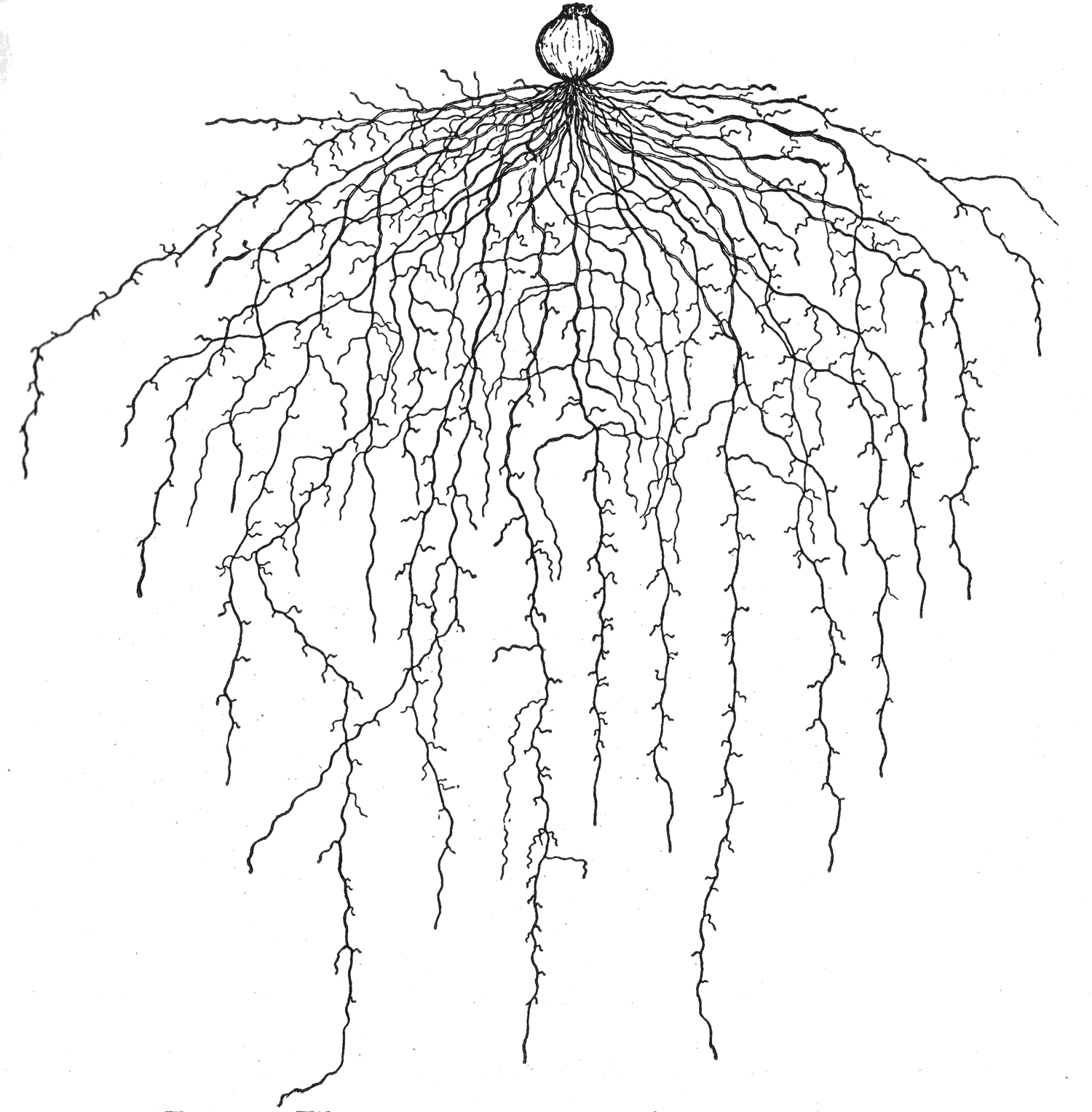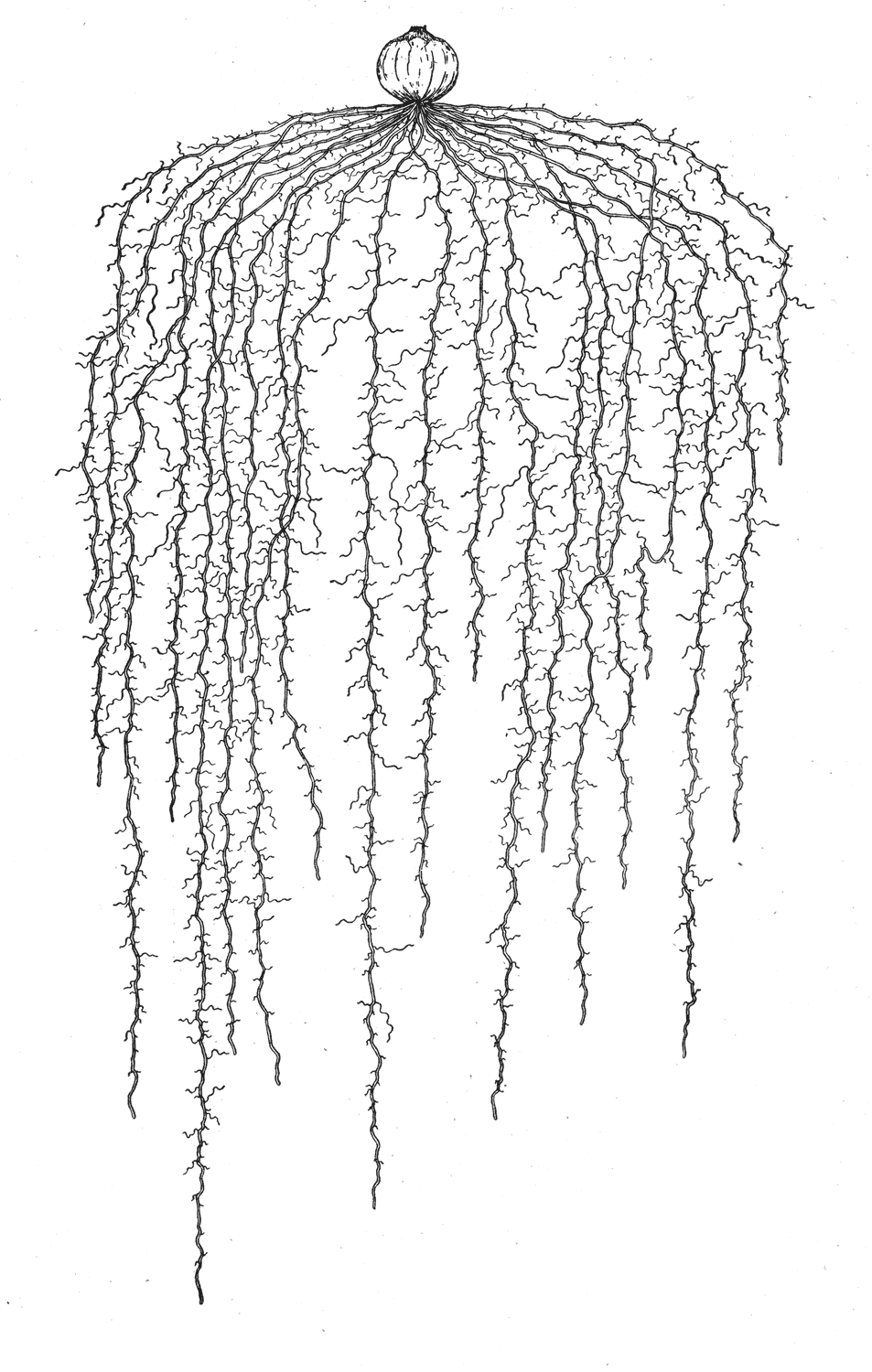Onion
The common onion
(Allium cepa) is a biennial with large bulbs that are usually single. It is the most important bulb crop and is exceeded in value by only four other vegetable crops grown in the United States, viz., potatoes, sweet potatoes, tomatoes, and cabbages. Like all the other bulb crops it is hardy and, in the North, is planted very early in the spring. In the South it is grown as a winter crop.
Southport White Globe Onion
For root examination the Southport White Globe onion was planted Apr. 10. Especial care was exercised to have the soil fine and loose and with a smooth surface, since the seeds are small and do not germinate quickly. Thorough preparation of the soil is an essential feature in the successful growth of nearly all crops.
Early Development
The onion develops a primary root which, under very favorable conditions, may reach a length of 3 to 4 inches 10 days after the seed is planted. In the meantime the cotyledon comes from the ground in the form of a closed loop. By the time the first foliage leaf emerges from the base of the cotyledon, several new roots make their appearance near the base of the stem.
The first field examination was made June 4. The plants were about a foot tall and had an average of four leaves each. These varied from 4 to 12 inches in length and 2 to 5 millimeters in diameter. The total area of the cylindrical leaves per plant averaged 8.5 square inches. Each plant was furnished with 10 to 12 delicate, shining white, rather poorly branched roots (Fig. 7).
Fig. 7
An onion 8 weeks after the seed was planted.
Effect of Soil Structure on Root Development
To determine the effect of loose and compact soil on root growth, onions were grown in rectangular containers with a capacity of 2 cubic feet and a cross-sectional area of 1 square foot. A fertile, sandy loam soil of optimum water content was screened and thoroughly mixed and thus well aerated. One container was filled with very little compacting of the soil. It held 173 pounds. Into the second container 232 pounds of the soil were firmly compacted.
Fig. 8
Onion seedlings of the same age. The one on the right was grown in compact soil and that on the left in loose soil. Both drawings are made to the same scale.
The effects on root growth are shown in Fig. 8. In the hard soil the plants nearly always possessed six roots but only five were found on those in the loose soil. Under the former conditions the vertically descending roots reached depths not exceeding 5 inches; the others spread laterally 1 to 1.5 inches and then, turning downward, penetrated to a total depth of 2.5 to 3 inches.
Half-grown Plants
By July 25 the bulbs had reached a diameter of 0.5 to 1.8 inches. From 28 to 33 roots arose from the base of each of the bulbs, i.e., at a depth of 1.5 to 2 inches. Nearly all of these smooth, shining white roots were a millimeter in diameter although a few were only 0.5 millimeters thick. The longest frequently maintained their initial diameter for distances of 5 to 10 inches; others quickly tapered to a thickness of only ½ millimeter.
Some of the main roots ran outward, almost parallel to the soil surface, to distances of 6 to 8 inches before turning downward at an angle of about 45 degrees. These had a maximum lateral spread of about 12 inches on all sides of the plant.
Fig. 9
Fibrous root system of onion, 3.5 months old.

As a whole the main roots were poorly branched. In the surface 8 to 10 inches of soil branching occurred at the rate of 2 to 6 laterals per inch of main root, although sometimes as many as 12 were found. Many of the laterals were only 0.5 to 1 inch long, but some reached lengths of 4 to 5 inches. Below 8 inches depth, branches were often fewer and usually shorter, seldom exceeding 1 inch in length. The last few inches of the rapidly growing roots were unbranched.
Mature Plants
By Aug. 21 the plants had reached a height of 19 inches. Each had four to six leaves which varied in diameter from 0.5 to 0.75 inch. Owing to dry weather the plants were not flourishing and the leaf tips were dry. The bulbs averaged about 2 inches in diameter.
From 20 to 25 roots arose from the base of the bulb. A few ran vertically downward but most of them ran outward at various angles, even to near the horizontal, and then gradually turned downward. The volume of soil delimited at the previous excavation (which had an area on the surface of about 4 square feet) had not been increased except in depth. The former working level of 20 inches had been extended to 32 inches. A maximum depth of 39 inches was found (Fig. 10).
Fig. 10
A maturing onion excavated August 21. Root growth is not yet completed. Some of the roots shown in Fig. 9 had died.

The uncompleted root growth was shown by the 2 to 5 inches of unbranched or poorly branched, glistening white, turgid root ends. The main roots were very uniform in appearance and about 2 millimeters in diameter throughout their course. They were somewhat kinked and curved, perhaps owing in part to the difficulty in penetrating the rather compact soil.
Death of the Older Roots
The decrease in the number of roots from 28 to 33 on July 25 to 20 to 25 on Aug. 21 is of interest for it is one of the few cases found among vegetable crops where the roots die before the plant approaches or reaches maturity. That death of the older roots originating from the center of the bulb actually occurs was further confirmed by greenhouse studies.
Plants were grown from seed in appropriate containers which held 2 cubic feet of soil. When the plants were nearly 3 months old (June 23) and some roots had attained a depth of 22 inches, the sides of the containers were cut away and the roots examined.
Similar observations have been made in both water and soil cultures. "It was observed that the roots formed at the time of germination died at about the time of the formation of the bulb, and that new ones then developed and carried the plants through their complete life cycle."
(a) to the senility of the stem tissues,
(b) to the senility of the roots proper, and
(c) to the convolutions which are formed in the tissues of the stem as the result of irregular growth between old and new tissues and which bring about, quite often, disconnections in the water- and food-conducting tissues. 138
Footnotes
93National LLOYD, J. W. Onion culture. Ill. Agr. Exp. Sta., Circ. 173. 1926. Access Online
138 SIDERIS, C. P. Observations on the development of the root system of Allium cepa L. Am. Jour. Bot., 12: 255--258. 1925. Access Online
Next Chapter
Soil Types
Activate one of the layers to get more information.
Soil Moisture
Amout above the hygroscopic coefficient:
It is a well-established fact that rainfall is only a very general indicator of soil moisture, since many other factors both climatic and edaphic intervene between precipitation and water available for plant growth. Hence, a study of the soil moisture in several of the plats was made from time to time
Spread
A working level of 20 inches and a maximum depth of 27 inches were attained.
Some of the main roots ran outward, almost parallel to the soil surface[…]. These had a maximum lateral spread of about 12 inches on all sides of the plant.
(…)
Details
Activate one of the circles to get more information.